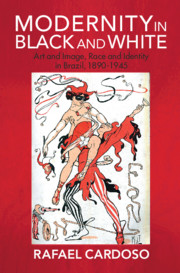Book contents
- Modernity in Black and White
- Afro-Latin America
- Modernity in Black and White
- Copyright page
- Dedication
- Epigraph
- Contents
- Figures
- Acknowledgements
- Notes on Usage of Brazilian Portuguese
- Introduction
- 1 Heart of Darkness in the Bosom of the Modern Metropolis
- 2 A Pagan Festival for the Up to Date
- 3 The Printing of Modern Life
- 4 The Cosmopolitan Savage
- 5 The Face of the Land
- Epilogue
- Index
2 - A Pagan Festival for the Up to Date
Art, Bohemianism and Carnival
Published online by Cambridge University Press: 06 April 2021
- Modernity in Black and White
- Afro-Latin America
- Modernity in Black and White
- Copyright page
- Dedication
- Epigraph
- Contents
- Figures
- Acknowledgements
- Notes on Usage of Brazilian Portuguese
- Introduction
- 1 Heart of Darkness in the Bosom of the Modern Metropolis
- 2 A Pagan Festival for the Up to Date
- 3 The Printing of Modern Life
- 4 The Cosmopolitan Savage
- 5 The Face of the Land
- Epilogue
- Index
Summary
The rise of modern carnival in Rio de Janeiro, over the early twentieth century, provided an outlet for defusing the enormous social and cultural tensions of the modernizing metropolis. The so-called Great Societies of carnival, which have been little researched, functioned as zones of contact between popular culture and fine art practitioners, some of whom developed pioneering careers as carnival scenographers (carnavalescos). Contrary to received wisdom, exchanges and encounters between the worlds of art and carnival were numerous and varied. The 1913 Salon of the National School of Fine Arts marks a watershed moment, in which the restricted milieu of fine art openly embraced the urban culture of carnival, particularly in the work of painters Rodolpho Chambelland and Arthur Timotheo da Costa. These and other artists laid the groundwork for challenges to the prevailing institutional order, especially after 1916. Even earlier, over the early 1900s, a rebellious milieu of artistic bohemianism, revolving around painter Helios Seelinger, graphic artists Raul and K. Lixto, among others, sought to modernize artistic production in Rio by forging connections with music, dance, theatre, performance and carnival. Previously overlooked, their combined efforts represent an early modernizing current attuned to the adversarial attitudes of German Secessionism, from which they drew inspiration.
Keywords
- Type
- Chapter
- Information
- Modernity in Black and WhiteArt and Image, Race and Identity in Brazil, 1890–1945, pp. 72 - 126Publisher: Cambridge University PressPrint publication year: 2021

